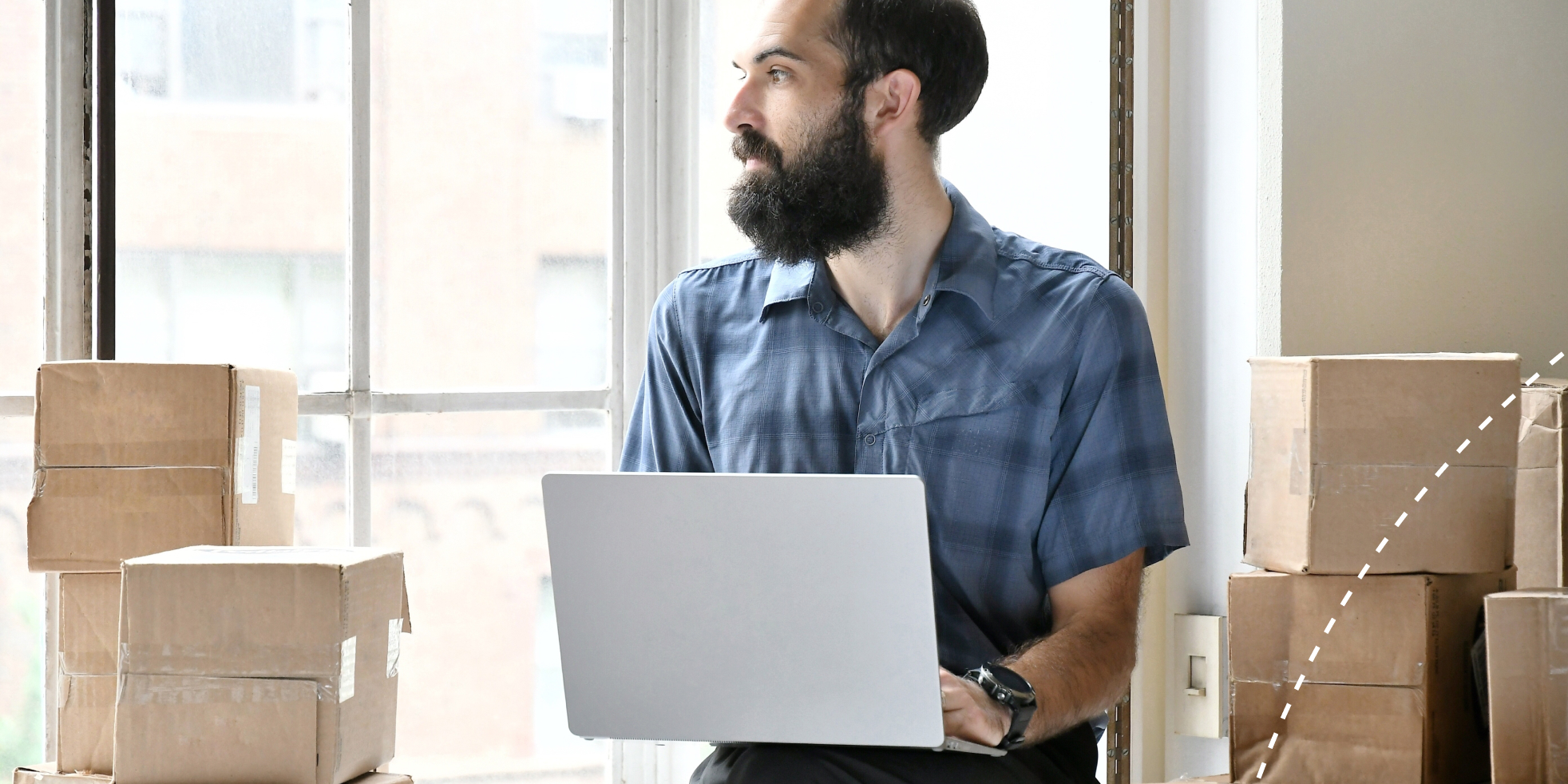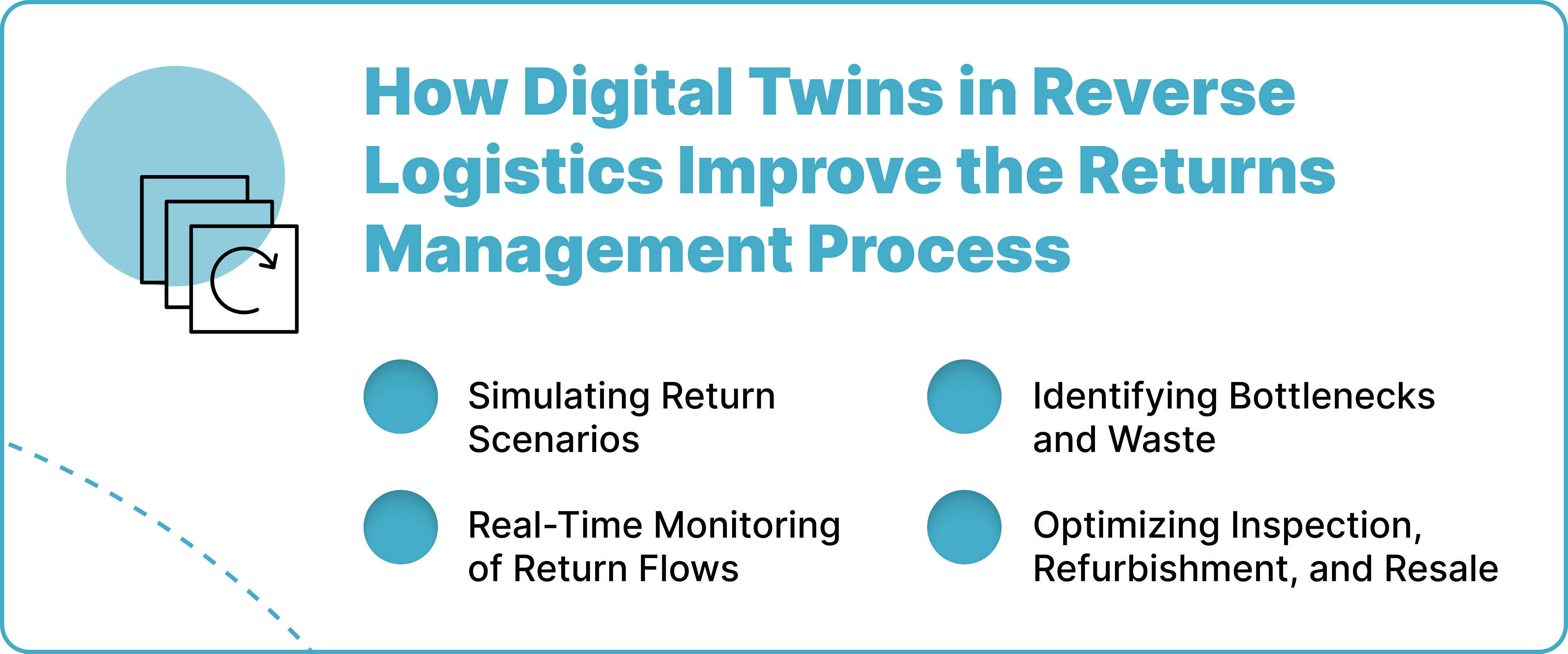The Role of Digital Twins in Reverse Logistics Optimization

Returns are now a regular part of doing business for both retailers and manufacturers. From online clothing orders to damaged electronics, the nature of the modern retail climate is that every day, products are being returned to the supply chain through a process commonly referred to as reverse logistics. However, it can be expensive, messy, and often unpredictable, which is why efficient reverse logistics and digital twins in reverse logistics are necessary.
Put simply, digital twins are digital copies of real-world systems. In the reverse logistics process, they enhance businesses’ ability to manage returns efficiently, eliminating the need for guesswork or trial-and-error. This way, your returns management team can test and improve how returns are handled before changes happen in real life.
With virtual modeling for returns, teams can see how small tweaks affect cost, time, and inventory, without risking delays or added waste. This article shows how the application of digital twins in reverse logistics helps retailers and manufacturers manage returns smartly. It covers what they are, how they work, and how they make reverse logistics smoother, faster, and more accurate.
What Are Digital Twins?
A digital twin is a computer model that simulates a physical object or system. It could be a warehouse, a delivery truck, a returns process, or an entire supply chain operation. The model gets real data from machines, software, or sensors, then uses that data to show what is currently happening and what might happen next.
Digital twins in reverse logistics enable teams to test changes before implementing them in real-life scenarios. They provide real-time visibility into the returns process, allowing for real-time monitoring and control. This involves testing new routes, policies, or layouts for product returns within a digital model, enabling data-driven decisions. Then, if it works well, they apply it to the real operation. This is smarter than relying solely on guesswork or spreadsheets. It also saves time and money.
Why Reverse Logistics Needs Optimization
Most companies focus more on getting products out the door, which is understandable. However, the problem with this is that product returns get less attention. With the rise of online shopping and increasingly complex products, returns are increasing at a rapid pace. Managing them has also become more expensive than ever.
The average reverse logistics includes the following steps:
- Updating inventory systems
- Managing refunds or credits
- Checking the product’s condition
- Restocking, repairing, or recycling
- Getting returned products from customers
These steps can be time-consuming and inefficient, leading to delays and increased costs.
Different teams or locations often handle these steps. This makes it difficult to track returns or predict associated costs. In many cases, a product may sit in limbo for weeks for any number of reasons, including:
- Late refunds
- Items lost in transit
- Wrong return labels
- Overstocked warehouses
These issues hurt profits and slow down operations. Poor returns management can result in significant financial losses, negatively impacting overall profitability. That’s why effective returns management, along with predictive return management and AI-driven logistics optimization, is now critical.
How Digital Twins in Reverse Logistics Improve the Returns Management Process

The reverse logistics and returns management process can be complex, particularly due to its inherent nature. Receiving different products in varying conditions, from customers with diverse reasons for making these returns, complicates matters.
Digital twins in reverse logistics can streamline the returns processing and significantly enhance the overall customer experience through the following: Automated order picking solutions, such as autonomous mobile robots and pouch systems, can further improve efficiency by quickly restocking returned items and optimizing inventory storage, thereby reducing costs and inaccuracies.
1. Simulating Return Scenarios
Retailers can utilize digital twins to simulate various scenarios in the returns process, including monitoring inventory levels to ensure accurate and up-to-date data for informed decision-making. This might include:
- Trying out new return center locations
- Testing a new courier service for pickups
- Changing the number of staff checking returned products
By running these ideas within a virtual model, managers can see what works best before making any real changes. For example, an online electronics retailer can leverage digital twins to test a new warehouse layout. This way, the company can monitor the handling time and adjust the layout for greater efficiency if necessary, without relocating a single shelf until the simulation is complete and the retailer is satisfied with the outcome.
2. Real-Time Monitoring of Return Flows
Digital twins can connect to real-time data, like scans from a return drop-off or updates from a courier. This creates a live map of the location of returned items, including their status at each distribution center.
Managers can use this view to:
- Spot bottlenecks in return routes
- Redirect items to underused return centers
- Send faster updates to customer support
- Manage unexpected disruptions in the returns process
This helps reduce delays and avoid congestion. A clothing retailer using digital twins logistics reduced average return cycle time from ten days to six.
3. Identifying Bottlenecks and Waste
Returns often bounce between locations or sit waiting too long. A digital twin shows where that happens. The visual model highlights areas where products accumulate or move slowly, emphasizing the importance of seamless integration with existing systems to identify these inefficiencies and enhance operational efficiency.
With this view, retailers can:
- Change inspection workflows
- Add or remove shipping partners
- Reduce handling steps for certain product types
This improves speed and saves on fuel, storage, and labor.
4. Optimizing Inspection, Refurbishment, and Resale
Many returned merchandise items can be repaired or cleaned and sold again. Others must be recycled or donated. But deciding what to do takes time, and mistakes cost money. Using virtual modeling for returns, businesses can test different rules based on product type, cost, or condition:
- Should this item be cleaned and resold at a discount?
- Is it cheaper to send it to another region?
- Can it be repaired in-house or by a partner?
- Can it be resold quickly at full price to maximize profit margins?
One electronics maker used a digital twin to adjust how returned phones were sorted. It increased the number of phones eligible for resale by 25%.
Returns Data Analysis
By analyzing returns data, companies can identify areas for improvement in their supply chain operations, reduce return rates, and improve customer satisfaction. Returns data analysis can also help companies identify opportunities to improve inventory management, reduce labor costs, and enhance overall supply chain efficiency.
Furthermore, by utilizing predictive analytics and digital twin technology, companies can simulate scenarios and forecast potential disruptions, enabling them to develop proactive strategies to mitigate risks and enhance customer loyalty. Additionally, optimizing supply chains and rethinking logistics through returns data analysis can help companies reduce their carbon footprint while maintaining profitability.
Benefits for Retailers and Manufacturers
Companies that use digital twins in reverse logistics see real improvements.
- Faster return handling: Simpler processes mean quicker restocks and refunds.
- Lower costs: Fewer steps, better routing, and smarter staffing all result in cost savings.
- Better inventory control: Real-time data helps prevent stockouts or overstocks.
- More value recovered: Fewer items are written off or discarded.
- Smaller environmental impact: Less waste and fewer unnecessary shipments.
- Clear return policies: Concise and easy-to-understand return policies enhance customer satisfaction and reduce hassle.
These gains enable businesses to operate more smoothly and serve customers more effectively by offering free returns.
Getting Started with Digital Twins in Reverse Logistics
To begin using digital twins, start small. Select one aspect of the returns process to model, such as a fulfillment center or a product category with a high return rate.
Steps to take:
- Map your current return process: Identify where items move, how long it takes, and who is involved.
- Collect data: Pull data from warehouse systems, transport tools, and customer return portals.
- Build the twin: Use modeling software to recreate the return flow.
- Run simulations: Test different ideas — like staffing changes or a new courier — and see the results.
- Hire skilled personnel: Ensure you have skilled personnel to effectively implement and manage the digital twin.
- Track and adjust: Use the insights gained from the model to inform real-world changes.
Many software providers offer digital twin tools for use in logistics and supply chain management. Some are designed for large operations, while others are suitable for mid-sized retailers.
Optimizing Technology For Reverse Logistics and Returns Management Optimization
Returns are here to stay — and they’re only getting more common in modern supply chains. Without better tools, they cost time, money, and customer trust. Digital twins enable retailers and manufacturers to take control of the returns process. With virtual modeling for returns, businesses can test ideas, monitor workflows, and resolve issues before they occur in real life. Accurate demand forecasting also plays a crucial role in optimizing reverse logistics by predicting return volumes and managing inventory efficiently. It’s not science fiction. It’s a clear, practical step toward smarter returns.
This is why ReverseLogix is so important. It is the only end-to-end return management system that lets you initiate returns, configure return processing, and even handle repairs. Connect with us today for a free demo.

Frequently Asked Questions
Yes, smaller businesses can benefit. While large manufacturers may have full-scale simulation labs, many software providers now offer entry-level digital twin tools tailored for small or mid-sized operations. These can be used to model just one part of the reverse logistics chain, like warehouse restocking or third-party return routing. Starting small allows teams to test real improvements without needing a massive investment.
A digital twin doesn’t just show what’s happening — it simulates what could happen. Dashboards track current return flows and delays, but a digital twin allows teams to test new return methods, warehouse layouts, or staffing models in a virtual space. This means fewer surprises when changes are rolled out in the real world.
You’ll need return volume history, item condition data, processing times, transportation updates, warehouse handling costs, and refund cycle details. Many businesses already collect this information through their warehouse management systems (WMS), transportation management systems (TMS), and order systems. Once connected, this data helps make the twin more accurate and valuable.
Results can begin in as little as weeks, depending on the scope. For example, if a company uses a digital twin to test a new way of handling high-volume returns like clothing or electronics, it may identify bottlenecks and reduce cycle times quickly. The key is to focus on one pain point, measure the before-and-after, and scale from there. Preparing for future challenges ensures that the solutions remain effective as the business grows and evolves.
